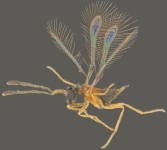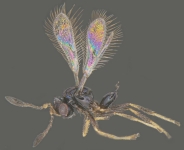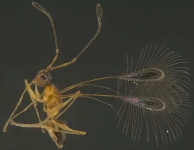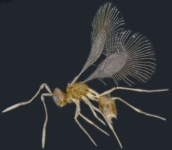Fairyflies (Mymaridae)
Fairyflies (Hymenoptera: Chalcidoidea: Mymaridae) are internal, primary parasitoids on insect eggs especially auchenorrhynchous Hemiptera, but eggs of other Hemiptera (Coccoidea, Tingidae, Miridae, etc.), Coleoptera (beetles), Odonata (dragonflies and damselflies), Psocoptera (booklice) and Thysanoptera (thrips) are also attacked. In his review of the hosts of mymarids, Huber (1986) stated that they particularly parasitize eggs in concealed situations such as those embedded in plant tissue, placed under scales, bracts or in soil. Few mymarids are also capable of swimming under water in search of their aquatic insect egg hosts, using their wings as oars. Because of their small size, they would not be able to break the surface tension of the water so that they climb the stems of plants. Among the aquatic mymarids, Caraphractus cinctus Walker parasitizes the submerged eggs of dytiscid (Coleoptera).
The family Mymaridae currently includes 98 genera and 1424 species in the world, 167 species in 27 genera from the Oriental region and 104 species in 24 genera from India (See Universal Chalcidoidea Database). Mymarids are usually solitary, but sometimes gregarious parasitoids, as well as very tiny insects, averaging only 0.5 to 1.00 mm long and their bodies are usually non-metallic and coloured black, brown or yellow. Minute sized mymarids are difficult to find and are often overlooked even by entomologists searching for them in sweep net catches or from traps (Malaise trap, pan traps).
Economic importance
Mymarids have been utilized in the biological control programmes of insect pests of agricultural and horticultural crops. The Eucalyptus snout-beetle, Gonipterus scutellatus Gyllenhal, a serious pest of Eucalyptus in South Europe, South Africa, New Zealand and South America was controlled by the introduction of Anaphes nitens (Girault) (=Patasson nitens Girault) (Tooke, 1955). Apart from this, another species Anagrus armatus (Ashmead) was used to control the leafhopper Typhlocyba froggatti Baker, a pest of apple (Dumbleton, 1934). Huber (1986) and Bin (1994) discussed other attempts of biological control using mymarids.
Related taxa
Mymarommatidae, a distinct family now in a separate superfamily Mymarommatoidea, was earlier considered to be part of Mymaridae.
Mymarommatidae can be diagnosed by the following combination of characters:
(i) head has a hyperoccipital band of pleated membrane that enables the occipital region to expand and contract in a bellows-like manner,
(ii) forewing membrane with a mesh-like pattern,
(iii) hind wing reduced to an apically bifurcate haltere-like structure, and
(iv) petiole composed of two tubular segments.
See factsheet on Mymaromma.
|
 Anagrus Anagrus Haliday
 Camptoptera Camptoptera Foerster
 Himopolynema Himopolynema Taguchi
 Mymar Mymar Curtis
 Mymaromma Mymaromma Girault
|